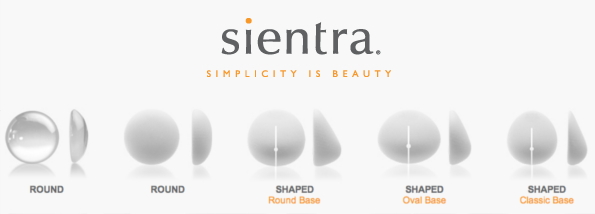Saline vs. Silicone
This week, I am continuing to talk about Breast Augmentation, specifically Breast Implant Deflation. As mentioned in last week’s post about Saline Breast Implant Deflation, Silicone Breast Implant Deflation is quite different. A Saline Breast Implant is essentially filled with water. Saline is slightly salty water (0.9% NaCl) that matches the saltiness of our bodies. When saline leaks out of the implant, it is absorbed. Saline quickly disappears without a trace, and it is not dangerous.
Saline or Silicone? Saline and Silicone Breast Implants feel different, but give similar results visually.
Get to Know Your New Silicone Filled Breast Implants
Modern Silicone Breast Implants are filled with a soft, but nearly solid, silicone gel. The consistency is like a soft, “indestructible,” stress ball. The latest high strength, highly cohesive silicone gel breast implants are also form-stable. This means they maintain their shape. The phenomenon is similar to Gummy Bear candies. These soft bears can be compressed flat, and will return to there original bear shape once released. This is why the latest silicone breast implants are frequently referred to as Gummy Bear Breast Implants. The video below makes it clear what happens when there is a hole in the shell of a silicone breast implant.
Video of the Inside of a Gummy Bear Breast Implant
This Breast Implant Rupture Video demonstrates what happens to the silicone filled breast implant’s contents after massive failure of the breast implant’s shell. Even when cut completely in half, the gel maintains its shape and integrity. It is soft, but does not flow. The high strength silicone gel changes shape easily when squeezed, and returns to its original form when the deforming force is removed. High tech meets high aesthetics.
Not Your Mother’s Breast Implants
Gummy Bear Breast Implants are a giant leap forward from the older silicone filled breast implants. Breast Implants manufactured before 1985 were filled with a silicone gel that behaved more like a liquid than a solid. When the breast implant ruptured, the silicone oil/gel would migrate into the breast and cause lumps of scar tissue. After 1985, the gel was made more cohesive, and the shells were made stronger. Implants after 1994 are less likely to leak, have very little “gel-bleed” (the ability of the gel to pass through the shell like helium through a balloon), and the gel inside them is less likely to migrate. If you are interested in the older breast implants, check out the History of Breast Implants.
Who Makes the Strongest Breast Implants?
The implant manufacturer which currently has the strongest silicone gel is Sientra. Their five-year follow-up data shows zero cases of gel migration. As a Board Certified Plastic Surgeon specializing in Breast Augmentation Revisions, who has spent many an afternoon cleaning up pre-1985 ruptured breast implants, this is welcome news. This means if your modern silicone filled breast implants rupture, the gel will not immediately begin to migrate, and has a very high likelihood of staying in the pocket. But this causes a different problem, which I discuss below under “Silent Leaks”.
Silicone Breast Implant Deflation
Silicone Breast Implants Deflations should always be addressed as soon as it is medically safe. Unlike with Saline Breast Implants, delaying correction can cause more problems than just the pocket tightening, especially if you have older technology Silicone Breast Implants.
Silicone, unlike Saline, does not absorb into the body. Instead, the body tries to contain it by making a pocket of scar. For an intact Breast Implant, this works very well. The pocket surrounds and supports the implant, keeping it in the desired position. When a Silicone Breast Implant Ruptures, initially the gel remains within the breast implant’s pocket. With newer highly cohesive and gummy bear breast implants, the gel tends not to flow.
Older Breast Implants Are Messy When they Leak
For older, pre-1994, silicone filled breast implants, long term studies show that the more liquid-like silicone gel in older breast implants can migrate outside the pocket on the order of 14% per year. This means that if we follow 100 women who have older silicone gel filled breast implants that are already ruptured for one year, fourteen of them will develop gel migration outside the containment of the breast implant pocket. This gel migration may become evident as a change in shape of the breast implant, sudden softening of the implant, or lumps in the breast as the body tries to form a new pocket around the leaking gel.
Silent Silicone Breast Implant Leaks
The latest generation of breast implants have a strong, fairly solid center. The scar pocket contains this highly cohesive gel, much like the breast implants shell does, even after there is a leak. This makes it difficult to tell when the implant has leaked on physical examination. This is termed a silent leak, something that cannot happen with saline breast implants. What problems a silent leak can cause when the gel is still contained are not clear, but it is recommended to have any Leaking Silicone Breast Implant replaced before it can cause the problems outlined above. The FDA has recommended obtaining an MRI at three years, and then every two years after breast augmentation with silicone breast implants. With the data coming from the long-term breast implant follow-up studies showing reduced or no gel migration with the newest generation of breast implants, this recommendation may be modified in the future.
Breast Implant Revision Surgery
Breast Augmentation remains the most popular Cosmetic Plastic Surgery. While many women will keep their original implants for life, other will benefit from Breast Implant Revision Surgery.
If you are considering Breast Implants, or would like Breast Augmentation Revision, a Board Certified Plastic Surgeon is your best bet for a great result. If you are near the San Francisco Bay Area, give me a call in Walnut Creek, California, at (925) 943-6353, or use the contact form to the left for more information.
Previous Post Next Post